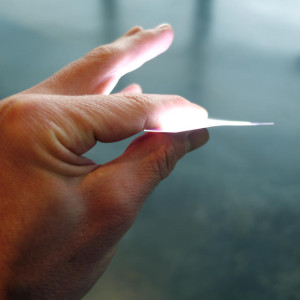Rohinni’s Lightpaper Is Incredibly Thin, And Printable

 In its current state, Lightpaper is manufactured by mixing ink and tiny LEDs together and printing them out on a conductive layer. That object is then sandwiched between two other layers and sealed. The tiny diodes are about the size of a red blood cell, and randomly dispersed on the material. When current runs through the diodes, they light up.
In its current state, Lightpaper is manufactured by mixing ink and tiny LEDs together and printing them out on a conductive layer. That object is then sandwiched between two other layers and sealed. The tiny diodes are about the size of a red blood cell, and randomly dispersed on the material. When current runs through the diodes, they light up.
Rohinni isn't interested in the entrenched TV market. The company would rather put the technology to use where it can make a big difference soon; everything from illuminating a logo on a mobile phone to providing headlights for a car. A few companies are already working on Lightpaper implementations, but Smoot wouldn't name any.
Consumers should start to see Lightpaper in the wild around the middle of 2015. But Rohinni won't be aiming at the home hobbyist market until after it takes hold in the commercial and industrial space.
The big problem with the product's current, version one, is how it places the LEDs when printed. Right now, they aren't distributed evenly on the printed surface. This can cause a shimmering, or starry night effect. Smoot explained that for a lot of applications, this won't matter, but the challenge being worked on currently is to get specific placement of the diodes—to produce completely even light. Not an insurmountable task, a second version of Lightpaper is likely a few months out.
"The magical thing about this solution is it's brighter, it's thinner, it's flexible, it's addressable, and programmable. You can address the sections of the diodes, which is a whole other space when you start thinking about solutions of light that you can address sections of."
See the full story here: http://www.fastcolabs.com/3038890/rohinnis-lightpaper-is-incredibly-thin-and-printable
Pages
- About Philip Lelyveld
- Mark and Addie Lelyveld Biographies
- Presentations and articles
- Tufts Alumni Bio